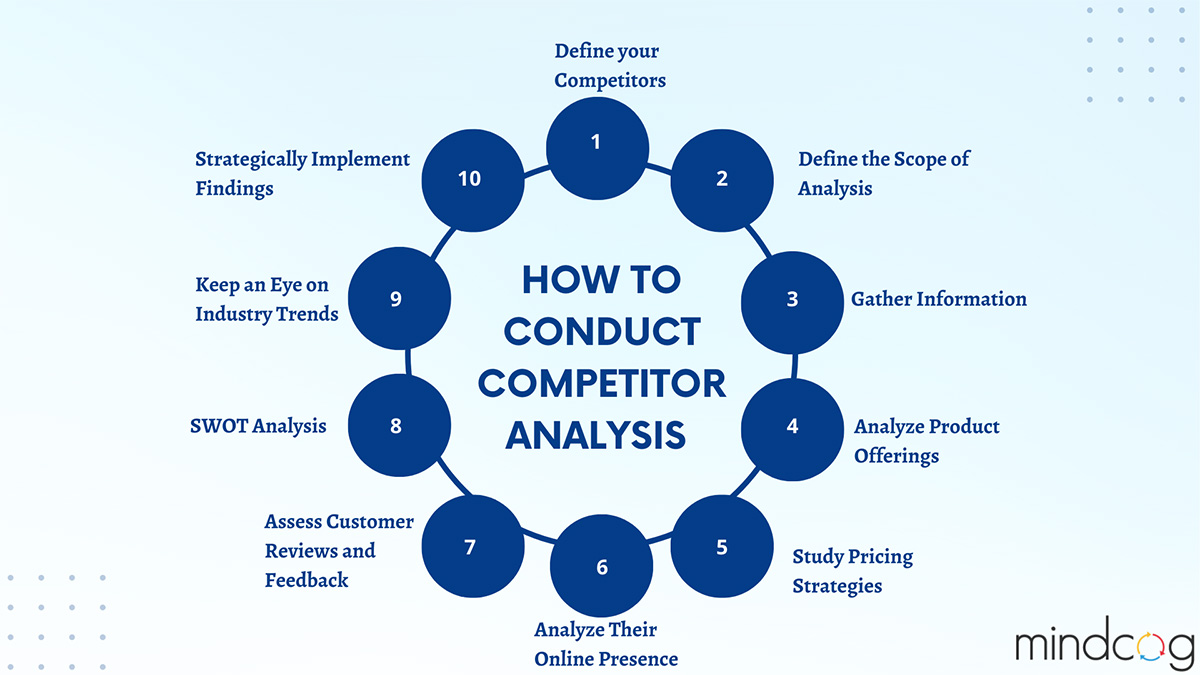Competitor analysis is an integral part of any successful market research strategy.
Understanding your competition provides valuable insights that can help you gain a competitive edge, identify market gaps, and refine your business strategies.
This article delves into the step-by-step process of conducting a comprehensive competitor analysis to help businesses thrive in today’s fiercely competitive markets.

- Define your Competitors: The first step in competitor analysis is to identify your main competitors. Look for companies that offer similar products or services, target the same customer base, and operate in the same market segment. Consider both direct competitors, who offer similar products or services, and indirect competitors, who may offer alternatives that can fulfil the same customer needs to create a clear picture of the competitive landscape.
- Define the Scope of Analysis: Determine the scope of your competitor analysis. Focus on specific aspects that are relevant to your business goals, such as product features, pricing strategies, marketing channels, and customer reviews. This focused approach will ensure that your analysis provides valuable insights without losing sight of your primary goals.
- Gather Information: Conduct thorough market research to gather relevant data about your competitors. Utilize a mix of primary and secondary research methods, including online surveys, customer feedback, social media listening, and competitor websites to obtain accurate and up-to-date information. Explore industry reports, market studies, and news articles to gain a comprehensive understanding of your competitive landscape.
- Analyze Product Offerings: Explore the intricacies of your competitor’s product offerings to gain a deeper understanding of their market position. By meticulously evaluating features, quality, pricing, and unique selling points assess how their products address customer needs and if there are any gaps that you can capitalize on. Understanding their product positioning will help you differentiate your offerings effectively.
- Study Pricing Strategies: Pricing plays a crucial role in the success of any business. Analyze your competitors’ pricing strategies and compare them with yours. Identify the factors that contribute to their pricing decisions, such as product features, quality, and positioning. Look for any price fluctuations, discounts, or promotions that may impact customer behaviour. Understanding their pricing strategy will help you determine whether your pricing aligns with market standards and help you optimize your pricing strategy for maximum profitability.
- Analyze Their Online Presence: Examine your competitors’ digital presence, including their website, social media platforms, and online advertising efforts. Evaluate the quality and relevance of their content, engagement with customers, and user experience. Identify the messaging they use to communicate with customers and how they position their brand in the market. This analysis will reveal insights into their branding strategies and customer engagement techniques.
- Assess Customer Reviews and Feedback: Customer reviews and feedback provide valuable insights into how your competitors are perceived by their customers. Explore online reviews, testimonials, and customer complaints to understand their strengths and areas for improvement. Incorporate positive aspects into your own customer experience strategies and learn from their negative feedback to avoid making similar mistakes.
- SWOT Analysis: Perform a SWOT (Strengths, Weaknesses, Opportunities, Threats) analysis for each of your main competitors. This analytical tool will help you identify internal and external factors that impact their business. Understanding their strengths and weaknesses will enable you to capitalize on their vulnerabilities and protect yourself from potential threats they may pose.
- Keep an Eye on Industry Trends: Stay updated with the latest trends, technological advancements, and innovations in the industry. This knowledge will enable you to anticipate changes in customer demands and market dynamics, keeping your business adaptable and relevant.
- Strategically Implement Findings: Once you have gathered and analyzed all the relevant data, it’s time to put your findings to use. Develop a well-defined strategy based on the insights gained from your competitor analysis.
Conducting competitor analysis is not just about gathering information; it is about using that information strategically to gain a competitive advantage. By understanding your competition, you can refine your business strategies, better meet customer needs, and create a winning market strategy. Embrace competitor analysis as a continuous process to stay ahead in the ever-evolving business landscape and drive sustainable growth for your organization.

